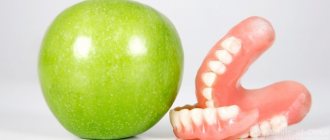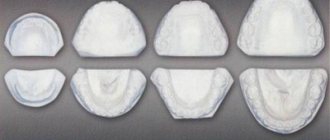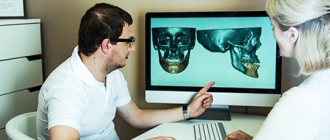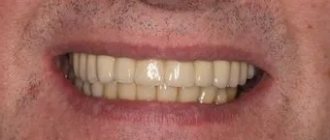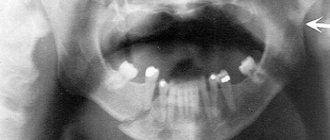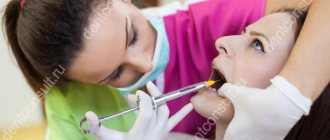A physiologically correct bite is the basis of not only a beautiful smile, but also the quality of the general condition of the entire body. Bite deviations can and should be dealt with regardless of the severity of the defect. Modern orthodontics can cope with any pathologies.
The Herbst appliance is a fixed orthodontic structure designed to correct distal occlusion (when the upper jaw is significantly larger than the lower jaw). Its use can be either an independent method of treatment or an additional means of correction.
Design features of the Herbst apparatus
As you know, distal occlusion is one of the most difficult to treat. This is due to deviations in the development of the entire jaw apparatus, and not just a violation of the position of the dental units.
The Herbst apparatus is made from individual casts of the patient’s jaw from titanium alloys and inert steel.
The design contains:
- two beams (telescopic, articulated, not hindering the natural movements of the jaws);
- four support crowns;
- metal rings for attaching beams to crowns.
Impression from the upper jaw
The specialist’s algorithm of actions includes 4 stages:
- The mouth opens wide and the spoon is placed on the high frequency. The displaced product is shortened behind the modular tubercle.
- Cheeks retract. The device is shed by the buccal cords, and its dimensions decrease near the sixth, seventh and eighth teeth.
- The upper lip is pulled down and forward. When the location changes, the device is shortened by about 3, 4 and 5 teeth.
- Pulling the lips forward with a long tube. Shortening is performed around 12 dental units.
The test is considered completed if there are no displacements. Fitting should be done carefully to prevent significant reductions in the basis boundaries.
Evaluating the results of the HF fitting allows the specialist to create an impression tray of the ideal shape. After adjusting the listed parameters, the dentist begins to form an impression.
Operating principle of the Herbst apparatus
A non-removable orthopedic design is a very active device in its effects.
This effect is possible thanks to its operating principle:
- round-the-clock operation of the device on the patient’s jaw;
- the principle of forced constant pressure on the ligaments and muscles of the dentofacial apparatus, allowing the correct position of the lower jaw to be taken and the growth of the upper jaw to be restrained.
Duration of treatment period
Changes in the patient's appearance occur in the first days after the installation of an orthodontic device.
It takes 4-12 months for the functioning of the joints, ligaments and muscles of the dentofacial apparatus to change. The duration of the treatment period depends solely on the age of the patient and the degree of complexity of the pathology.
Impression from the lower jaw
There are six stages of creating a functional impression:
- Setting the workpiece to LF. The visitor closes his mouth and swallows the accumulated secretion. The muscles that compress the pharynx contract. When the spoon is dropped, distal shortening occurs.
- The person presses his tongue on his cheeks one by one. After dropping, the workpiece is shortened along internal oblique lines.
- The patient reaches his tongue to the corners of his mouth. The product is cut in zones 3, 4 and from the mouth.
- A man sticks out his tongue and reaches for the tip of his nose. Then he runs his tongue along his upper lip. The chin muscles become tense. The displaced tray is shortened near the front teeth on the intraoral side.
- The patient strains the pterygomaxillary muscles with the mouth wide open. Distal shortening.
- The cheeks are retracted, and as the position of the spoon changes, shortening is performed near 6, 7 and 8 units. As a result of tension in the mental muscles, the device is reset and created in the corresponding area.
Preparatory stage for installation of the Herbst apparatus
The complexity of the design requires special preparation of the patient for the installation procedure of the device.
To do this you will need:
- diagnose malocclusion using a comprehensive examination, including taking impressions, radiography, orthopantomogram, etc.;
- complete sanitation of the oral cavity (treatment of caries and inflammatory processes of the mucous membrane, professional hygienic teeth cleaning);
- preparation of upper molars and lower premolars for installation of supporting crowns on them;
- in the case of installing the structure on braces, telescopic beams are attached to their orthodontic arch using special centers;
- the final stage of installation consists of correction and adjustment of the telescopic mechanism.
Impression taking technique
Custom impression trays are created by a podiatrist in the dental office. The impressions obtained after the functional test are clearly aligned with the prosthetic fields. The product is pre-fitted.
Correction of the frenulum of the tongue, cheeks and lower lip is performed. Recesses are formed along the edges of the product. Depending on the location and size, the tubercles on the mucous membrane are closed completely or partially.
It is necessary to block the false mylohyoid lines and preserve the function of saliva drainage by Wharton's ducts.
During the manufacturing process of prosthetic products for edentulous jaws, potential changes in the structure of the gums are taken into account. To achieve reliable stabilization and fixation of orthopedic structures, it is necessary to obtain a clear image of the relief of the mucous membrane of the prosthetic bed. When making a dental tray for patients with edentia, the functional state of the soft tissues of the prosthetic field is taken into account.
When creating a prosthesis for toothless jaws, the tray is used as the base layer of the impression. Using corrective material of low viscosity, the doctor reliably recreates the relief of the mucous membrane.
Herbst tests are ineffective in cases of severe atrophy of the alveolar process. This is due to the fact that the methodology is standardized.
The material used to mark the boundaries of the print is plaster or silicone. Some dentists prefer silicone due to its plasticity.
Advantages and disadvantages of the Herbst apparatus
Despite the variety of types of modern orthodontic structures, the Herbst apparatus has a number of advantages that make it possible to successfully eliminate the most complex malocclusion pathologies.
These include:
- simplicity and reliability of design;
- high performance;
- due to the constant impact on the jaw, the therapeutic period of treatment is reduced;
- the adaptation period is practically absent;
- treatment of distal occlusion with the Herbst apparatus for children under 16-17 years of age, in some cases even replaces surgical intervention;
- the possibility of combining treatment with other devices and techniques;
- the enamel of multiple units of the dentition is not damaged;
- the design does not cause discomfort to its owner.
A few disadvantages include:
- quite large size of the device;
- low aesthetics;
- quite labor-intensive hygiene procedures.
Advantages of using the Herbst appliance in the treatment of distal occlusion
- The ability to accurately predict the result of orthodontic treatment using the device.
- Speed of treatment, because The device acts on the dental system constantly - 24/7.
- The device is hidden in the oral cavity, because installed on distant teeth.
- The device does not interfere with talking, smiling, or eating.
- The device is relatively small, has a smooth shape, the pistons repeat all articulatory movements, so it is relatively easy for the patient to get used to it.
- Serious damage is practically excluded.
- The Herbst apparatus can be used either independently or together with braces.
- The device has a therapeutic effect in case of breathing disorders - mouth and difficulty breathing.
- The Herbst apparatus can be installed even if there are problems with enamel.
- The device does not create any special obstacles to hygiene.
- The device can replace the surgical stage of treatment.
What awaits the patient during treatment using the Gebst apparatus?
The entire treatment plan for a particular patient is created step by step by the orthodontist when drawing up the orthodontic treatment plan, after the patient has undergone orthodontic diagnostics. This treatment plan is discussed with the patient and finalized before orthodontic treatment begins. Therefore, our patients fully understand what awaits them during treatment and at what stage this or that additional orthodontic equipment, including the Herbst apparatus, will be used.
The treatment of each patient is absolutely unique, but if we talk about the general, most commonly used scheme, then orthodontic treatment of a distal bite using the Herbst apparatus will look like this.
- Preparatory stage
. This stage includes:
- Sanitation of the oral cavity, i.e. treatment of teeth and gums if necessary. Particular attention will be paid to the supporting teeth, on which additional apparatus will be installed in the future.
- Professional oral hygiene is mandatory before starting any orthodontic treatment.
- Surgical preparation, if necessary, namely frenuloplasty and/or deepening of the oral vestibule.
- Fixation of braces
. The patient must undergo the 1st stage of orthodontic treatment, during which the teeth are aligned and the harmonious and correct shape of the dental arches of the upper and lower jaw is achieved. This means that all teeth must take their place. - Installation of the Herbst apparatus
. This stage corresponds to the 2nd stage of orthodontic treatment, during which a deep restructuring of the dental system occurs. This stage, in fact, is the stage of correcting the bite. The required time to wear the Herbst apparatus is from 3 to 10-12 months, after which the device is removed. - Continuation of orthodontic treatment with braces
. At this stage, the final correction is carried out and tight interdental contacts will be established. For this purpose, they often use orthodontic traction bands - elastics. - Retention period
is the period of retention of the result of orthodontic treatment. If the Herbst apparatus was used during treatment, the retention period will have some features: - It is MANDATORY to install a permanent retainer.
- It is advisable to combine the presence of a non-removable retainer with the wearing of a removable retention device - a removable splint-elastic positioner.
- The recommended duration of the retention period is at least 2 years.
Recommendations for patients undergoing treatment of distal occlusion using the Herbst apparatus.
We have formulated several simple rules that will make life easier for patients with the Herbst apparatus.
- The patient can brush his teeth as usual - the rules of oral care are the same as for any orthodontic treatment. Additionally, it is necessary to more thoroughly clean the distant teeth on which the device and the structure itself are attached. You may need to visit your hygienist more frequently for professional hygiene while your device is being treated.
- Patients with the Herbst apparatus do not need to completely change their diet - the apparatus does not become clogged with food, but it is advisable to exclude very hard and too sticky foods.
- Do not put too much force on the device - it is not designed for this and may break.
- Monitor the integrity of the structure of the device, inspect it regularly and carefully. The patient should be alerted to loose parts or bent of some element. If such defects are detected, you should contact your orthodontist as soon as possible, because the device may malfunction and you will not be able to move your jaw. Particularly dangerous is the breakdown of telescopic parts, which can injure the oral cavity and larynx.
Retention period after treatment with the Herbst apparatus
The final retention period is no less important than the therapeutic period. Since the non-removable Herbst appliance, as a rule, copes with complex cases of occlusion, retention takes longer than usual (about two years).
After the active influence of the orthodontic structure on the patient’s dental apparatus, his ligaments and muscles, it is important to qualitatively consolidate the functional changes in the new bite.
It is recommended to use retention products about 20 - 22 hours a day, so it is better to choose permanent type retainers.
Distal bite and methods for correcting it
A distal malocclusion is a malocclusion in which the lower jaw is strongly pushed back relative to the upper jaw. To correct a deep distal skeletal bite, braces alone are not enough, since the position of the lower jaw must be changed.
There are several methods for changing the position of the lower jaw (correcting distal bite):
- surgery to change the size of the jaws;
- use of neuromuscular technologies;
- use of the Herbst apparatus.
The Herbst apparatus may be an alternative to surgical correction of malocclusion in adults, since not all patients are ready for surgery.
Dial-Dent orthodontists, after in-depth diagnostics and carrying out all the necessary calculations, can accurately say whether the Herbst apparatus can be used as an alternative to surgery to correct the bite, and, if possible, carry out effective orthodontic treatment without surgery.
Commentary by the chief physician of Dial-Dent S.V. Tsukora: “Thanks to the fact that the clinic employs very experienced and competent orthodontists who are proficient in various techniques and can work with various equipment, we can offer our patients a choice of treatment methods. In any case, this will be high-quality treatment, but the patient can choose a more comfortable option. The Herbst appliance, as an alternative to surgical correction of the bite, has helped many patients achieve the desired result without stress.”
Final correction of the bite after removal of the Herbst appliance
After removal of the Herbst appliance, the patient wore orthodontic elastics to achieve more correct and tight interdental contacts. The duration of this stage was 6 months.
The final correction of the shape of the dentition and bite is the third stage of orthodontic treatment
The Herbst device was removed after 10 months.
Braces were attached to the teeth where crowns for the Herbst apparatus were installed. Correction of orthodontic treatment was carried out.
The patient continued to wear braces for another year. During this time, the teeth were finally aligned and physiological contacts between opposing teeth were achieved. Observation by the orthodontist continued every 1.5 months.
Fitting an individual spoon to the lower toothless jaw
Regardless of the method used to make an individual tray, it must be specially adjusted before taking an impression. They do it as follows. First, a spoon is inserted into the mouth and the patient is asked to open it slightly. If, with a half-open mouth, the spoon moves from its bed, it needs to be shortened along the entire vestibular edge. Further adjustment of the spoon is carried out using Herbst functional tests.
First test: swallowing and opening the mouth wide. If the spoon is thrown off during swallowing, it is necessary to shorten its edge from the place behind the tubercle to the mylohyoid line (Fig. 206, 1). Then ask the patient to slowly open his mouth. If the tray rises from behind, then it is shortened in the area from the tubercles to the place where the second molar will later stand (2). You can grind the spoon very close to the bumps, but they should never be left loose. If the front part of the spoon is raised, then its edge on the vestibular side is ground off in the area between the fangs (3).
Second test: run your tongue along the red border of the lower lip. If the spoon rises, then grind its edge running along the maxillary-hyoid line (4).
Third test: touch the tip of your tongue to your cheek with your mouth half closed. The location of the required correction is located 1 cm from the midline on the hyoid edge of the tray (5). When the tongue moves to the left, correction may be required on the right side; when the tongue moves to the right, correction may be required on the left side.
Fourth test: stick your tongue out towards the tip of your nose. Correction of the edge of the spoon is done at the lingual frenulum in a concave manner, but not in the form of a groove (6).
Fifth test: active movements of the facial muscles, pulling the lips forward. If the spoon rises at the same time, then you need to shorten its outer edge between the fangs again (3). Between the canine and the second premolar along the vestibular edge of the tray there is a place where the edge of it, which goes too deep, is pushed out passively by the tissue. If you place your index fingers slightly below the corners of the mouth and make massaging movements without pressure, then in this place (7) you can clearly feel the edge of the spoon going too deep. All movements, except the last one, must be performed by the patients themselves. The displacement of the spoon is verified by lightly pressing on it with the index finger. All sharp edges and irregularities that arise when sharpening the edge of the spoon must be rounded and sanded.
The sublingual portion of the edge of the prosthesis forms a particularly important section of the marginal valve. A roller 8-10 mm thick is formed from the thermoplastic mass, thinning towards the ends. After strongly heating the corresponding side, it is glued to the inner edge of the tray between the first premolars. It is very important that the roller fills the sublingual space, but in no case extends the spoon deeper. It is softened by passing it several times over the flame of an alcohol lamp or gas burner, cooled a little and a spoon is inserted into the mouth. The patient presses his tongue on the cheek to the right and left twice (as in the third test) and again puts it on the handle of the spoon, without sticking it out of his mouth. The thickness of the cushion depends on the distance between the sublingual salivary gland and the lower edge of the alveolar process. The greater this distance, the thicker the formed roller.
To obtain a functional impression, a layer of softened thermoplastic mass (Weinstein mass, wax, Kerr mass, etc.) is placed in the tray and pressed against the jaw. The edges of the impression are formed using the Herbst functional tests described above. To obtain a functional impression, Herbst proposed his composition of a thermoplastic mass called “adhesive.” Clinical observations (Kh. A. Kalamkarov, V. S. Pogodin, etc.) have shown that success in obtaining an impression is ensured by the nature of the samples and the accuracy of their execution, and any thermoplastic mass of good quality can be used as an impression material.
The convenience of using thermoplastic masses is explained by their following properties:
- 1) they have an extended plasticity phase, which allows for functional tests necessary to obtain a high-quality impression;
- 2) during the taking of an impression they always have the same consistency;
- 3) do not dissolve in saliva;
- 4) distribute pressure evenly;
- 5) allow you to repeatedly insert the impression into the mouth and make corrections, since new portions of the mass merge with the old ones without deforming the impression.
However, thermoplastic masses also have disadvantages. These include an inaccurate imprint, deformation in the presence of retention places. When cooled with cold water, they harden unevenly and may become deformed when removed from the mouth.
Giving preference to thermoplastic masses, at the same time it is necessary to have at your disposal several types of impression masses in order to use them in accordance with the specific clinical picture of the edentulous mouth and the type of impression (under pressure, without pressure, combined, etc.).
Preparation for orthodontic treatment
After agreeing to undergo orthodontic treatment, impressions were taken, the necessary measurements, examinations, and consultations with other specialists were carried out. As part of the Dental promotion, the patient received professional teeth cleaning using the Air Flow method as a gift.
Before starting orthodontic treatment, it was necessary to cure caries.
The patient was able to undergo treatment for dental caries at the Dental Center. The presence of the necessary specialists in one clinic makes the process of orthodontic treatment more comfortable.
After preparing the teeth and all the calculations, Damon-Q braces were fixed on the teeth.
Aesthetic correction after orthodontic treatment
Since the front teeth were disproportionate in size, at the end of the orthodontic treatment, Dial-Dent restored the front tooth with light-curing material Estelite Sigma Quick (Japan). The dentist who performed the restoration of the front tooth is T.I. Matienko.
Normalization of dentition forms is the first stage of orthodontic treatment
To normalize the shape of the dentition and the position of individual teeth, vestibular metal-composite braces Damon-3 for the upper jaw and Damon-3MX for the lower jaw were used.
The braces were fixed on the teeth, after which the patient visited the orthodontist every 1.5-2.5 months for monitoring and changing the arches. Orthodontic onlays were fixed on teeth 36, 35, 45, 46 in order to correct lingual occlusion and prevent unnecessary interdental contacts and damage to the equipment.
Photo 2 months after the start of treatment:
After another 3.5 months, new photographs were taken showing the process of changing the position of the teeth as a result of orthodontic treatment.
8 months after fixing the braces, the teeth became much straighter, the dentition acquired a good shape:
The first stage lasted 13 months.

